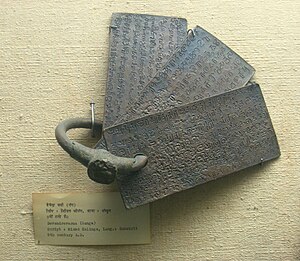
Back कलिंग लिपि ANP Kalinga (kirjoitusjärjestelmä) Finnish Kalinga írás Hungarian カリンガ文字 Japanese Alfabeta calinga LFN କଳିଙ୍ଗ ଲିପି OR కళింగ లిపి Tegulu อักษรกลิงคะ Thai
This article needs additional citations for verification. (June 2015) |
| Kalinga script | |
|---|---|
 Devendravarma (Ganga), Sanskrit in Mixed Kalinga script, 9th century AD. Copper plates, exhibited in the National Museum, New Delhi, India | |
| Script type | |
Time period | c. 600 - 1100 CE[1] |
| Languages | Odia language |
| Related scripts | |
Parent systems | |
Sister systems | Siddham, Sharada, Tibetan, Bhaiksuki |
| Brahmic scripts |
|---|
| The Brahmi script and its descendants |
The Kalinga script or Southern Nagari[2] is a Brahmic script used in the region of what is now modern-day Odisha, India and was primarily used to write Odia language in the inscriptions of the kingdom of Kalinga which was under the reign of early Eastern Ganga dynasty.[1] By the 12th century, with the defeat of the Somavamshi dynasty by the Eastern Ganga monarch Anantavarman Chodaganga and the subsequent reunification of the Trikalinga(the three regions of ancient Odra- Kalinga, Utkala and Dakshina Koshala) region, the Kalinga script got replaced by the Siddhaṃ script-derived Proto-Oriya script which became the ancestor of the modern Odia script.[3][4][5]
- ^ a b Diringer, David (1948). Alphabet a key to the history of mankind. Hutchinson.
- ^ Tripathī, Kunjabihari (1962). The Evolution of Oriya Language and Script. Utkal University. p. 28. Retrieved 21 March 2021.
Southern Nāgari (Cf. The later Kalinga script of Bühler)
- ^ Cardona, George; Jain, Dhanesh (2003). The Indo-Aryan Languages. Routledge language family series. London: Routledge. p. 487. ISBN 0-7007-1130-9.
- ^ Tripāṭhī, Kunjabihari (1962). The Evolution of Oriya Language and Script. Utkal University. p. 32. Retrieved 21 March 2021.
- ^ Ancient Kalinga script. Archived from the original on 2018-01-21.